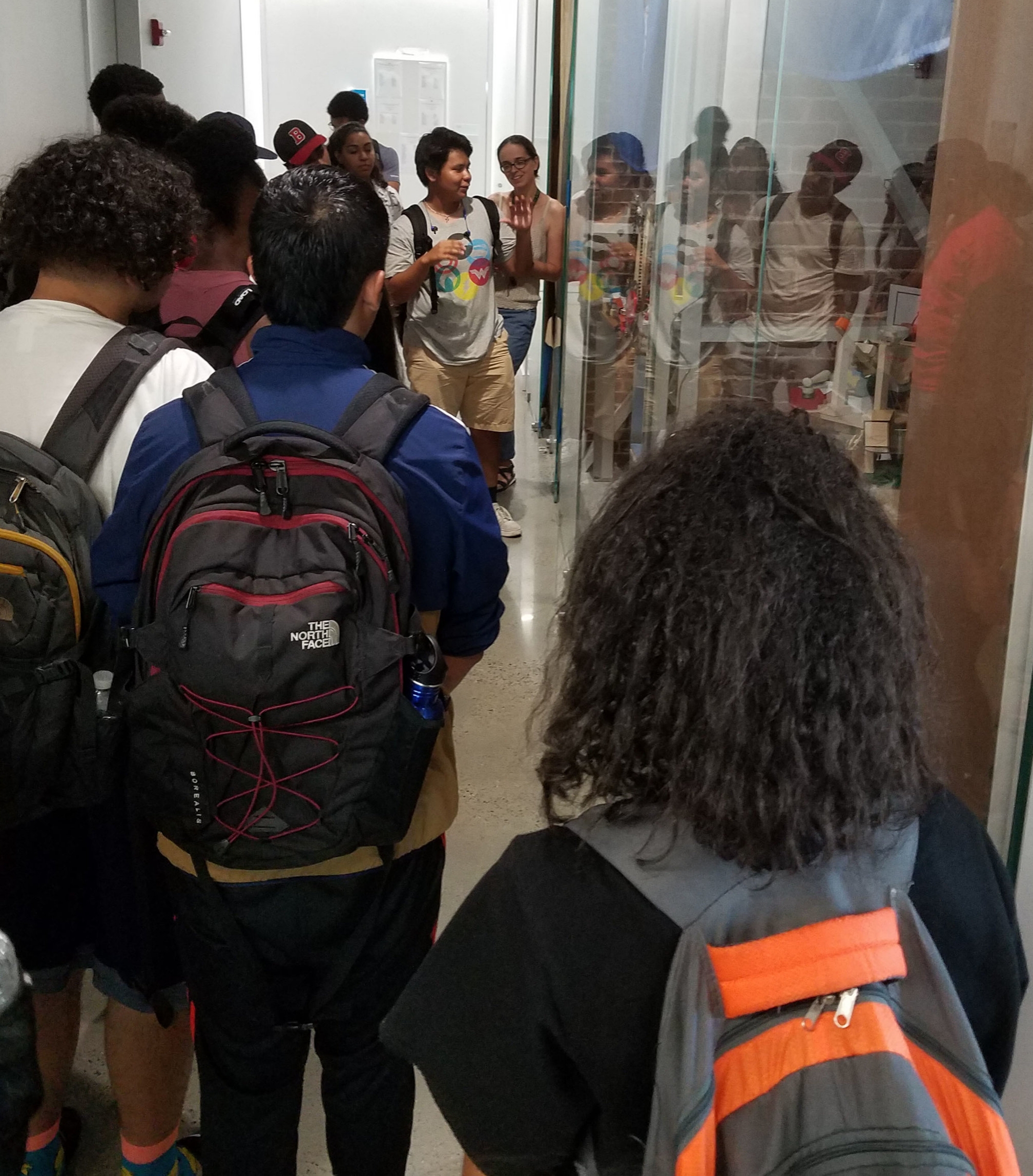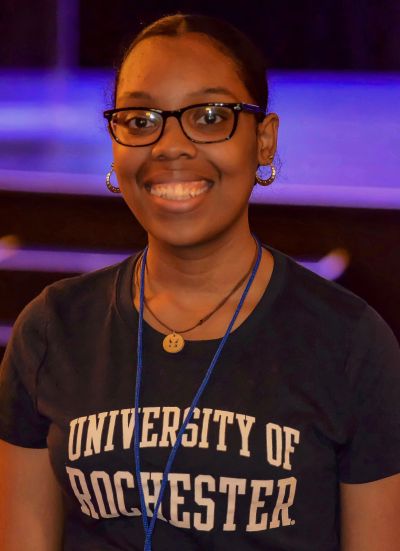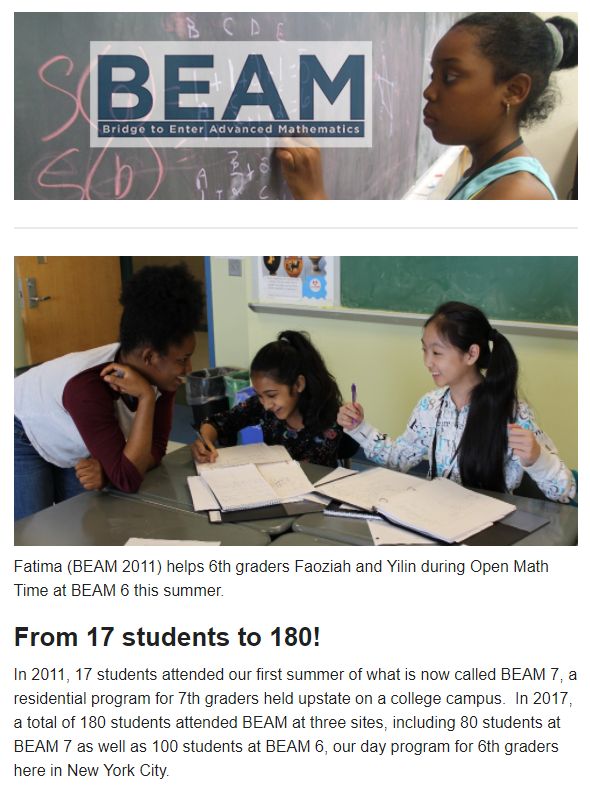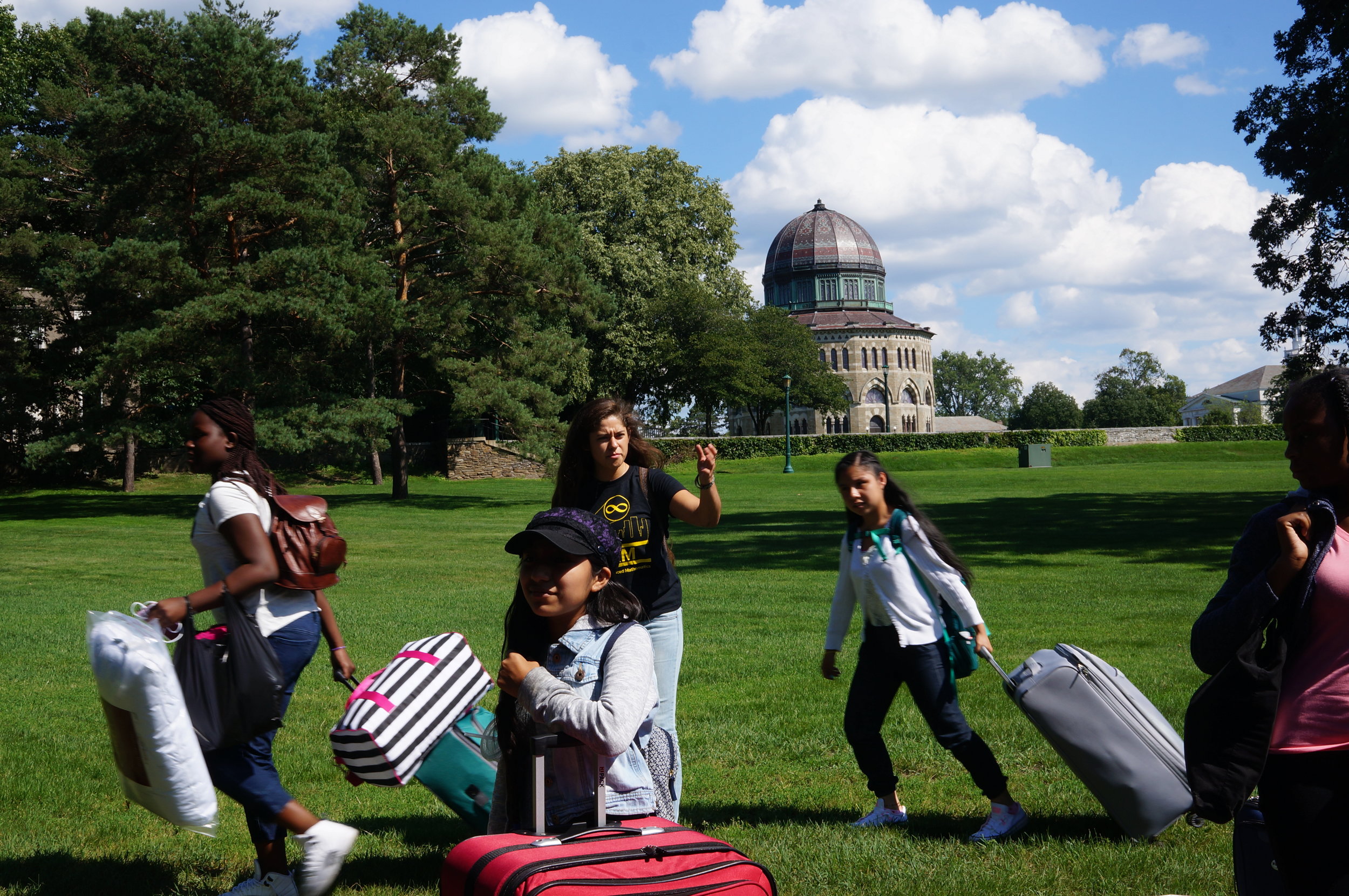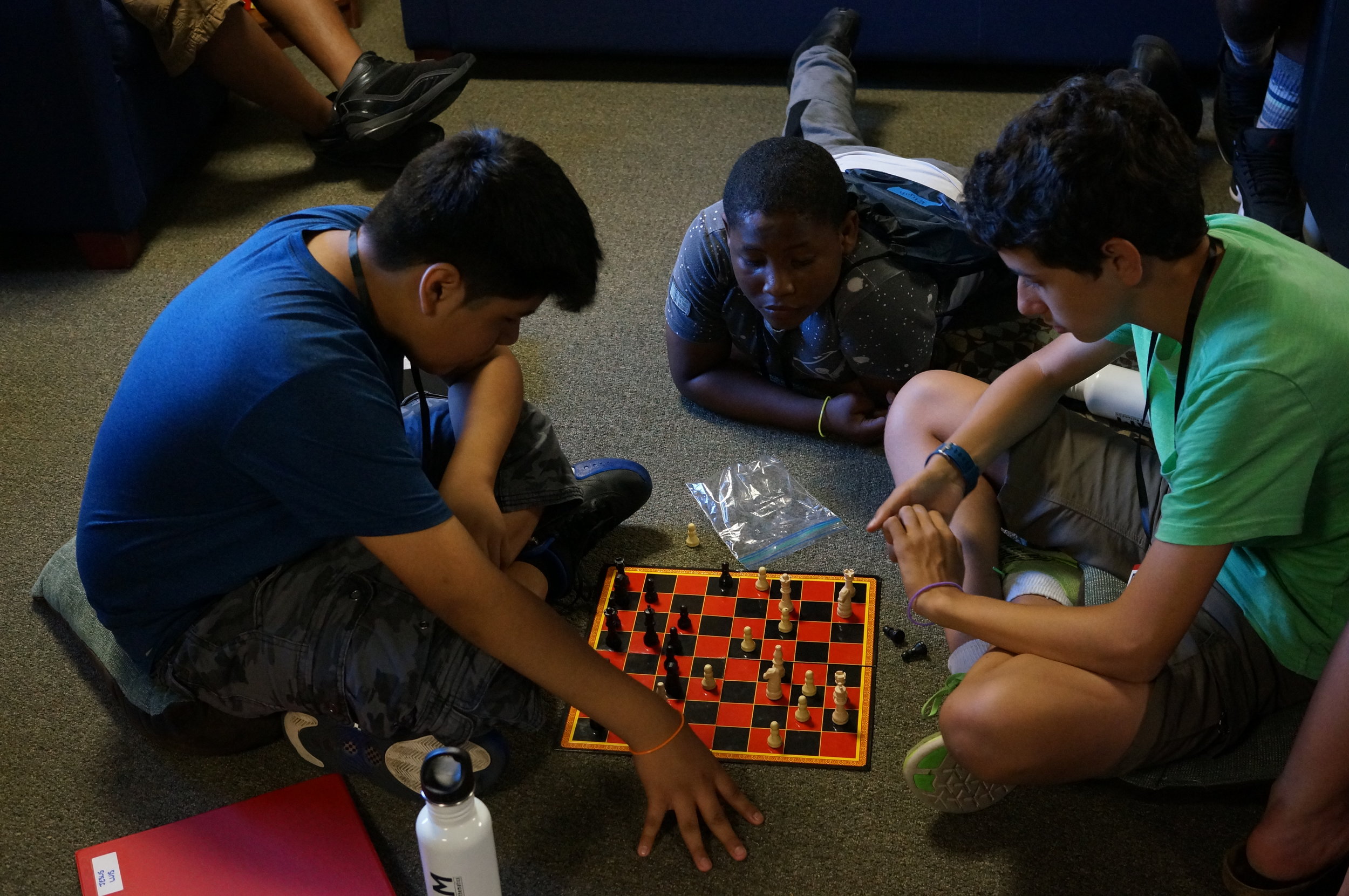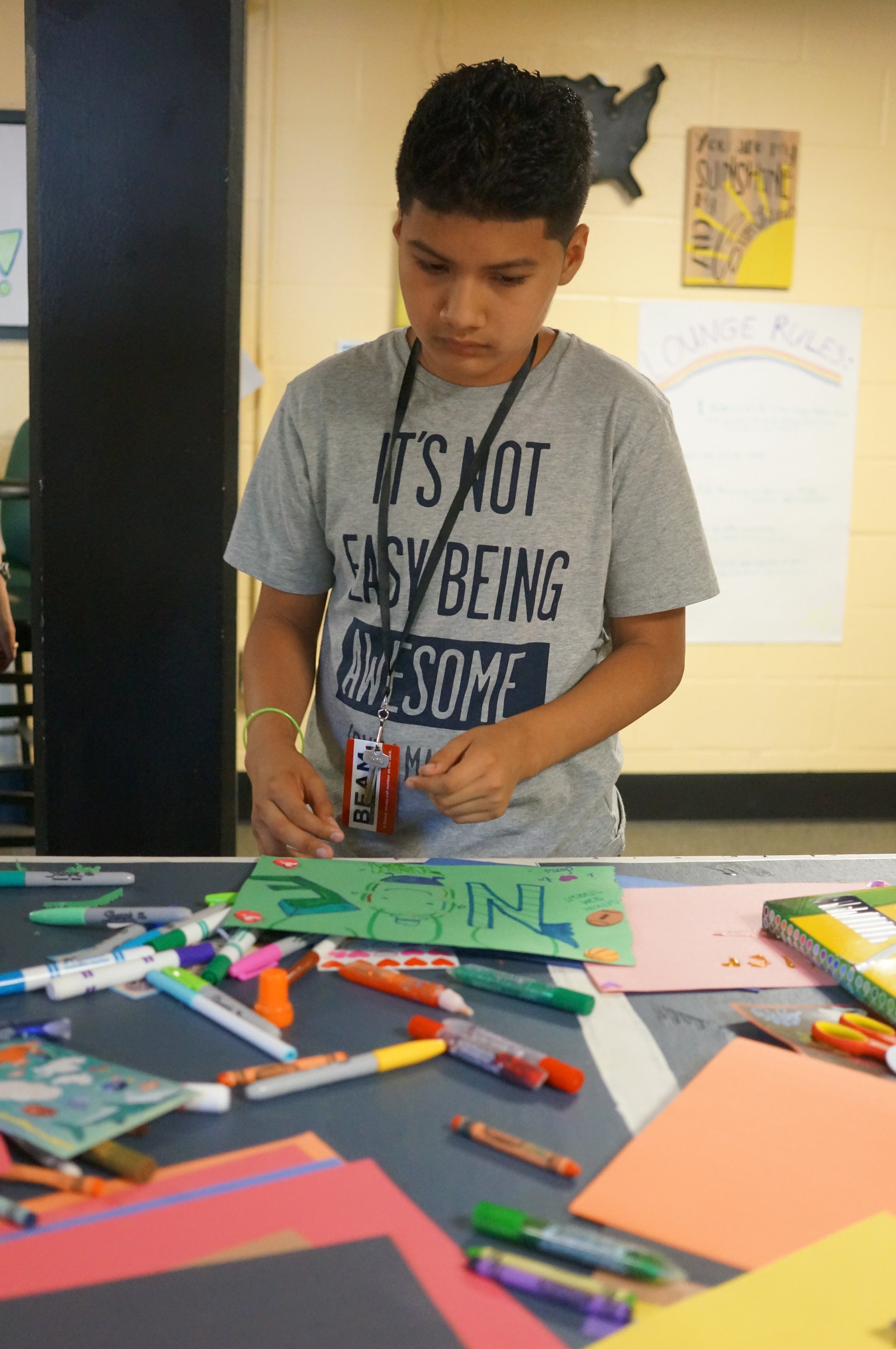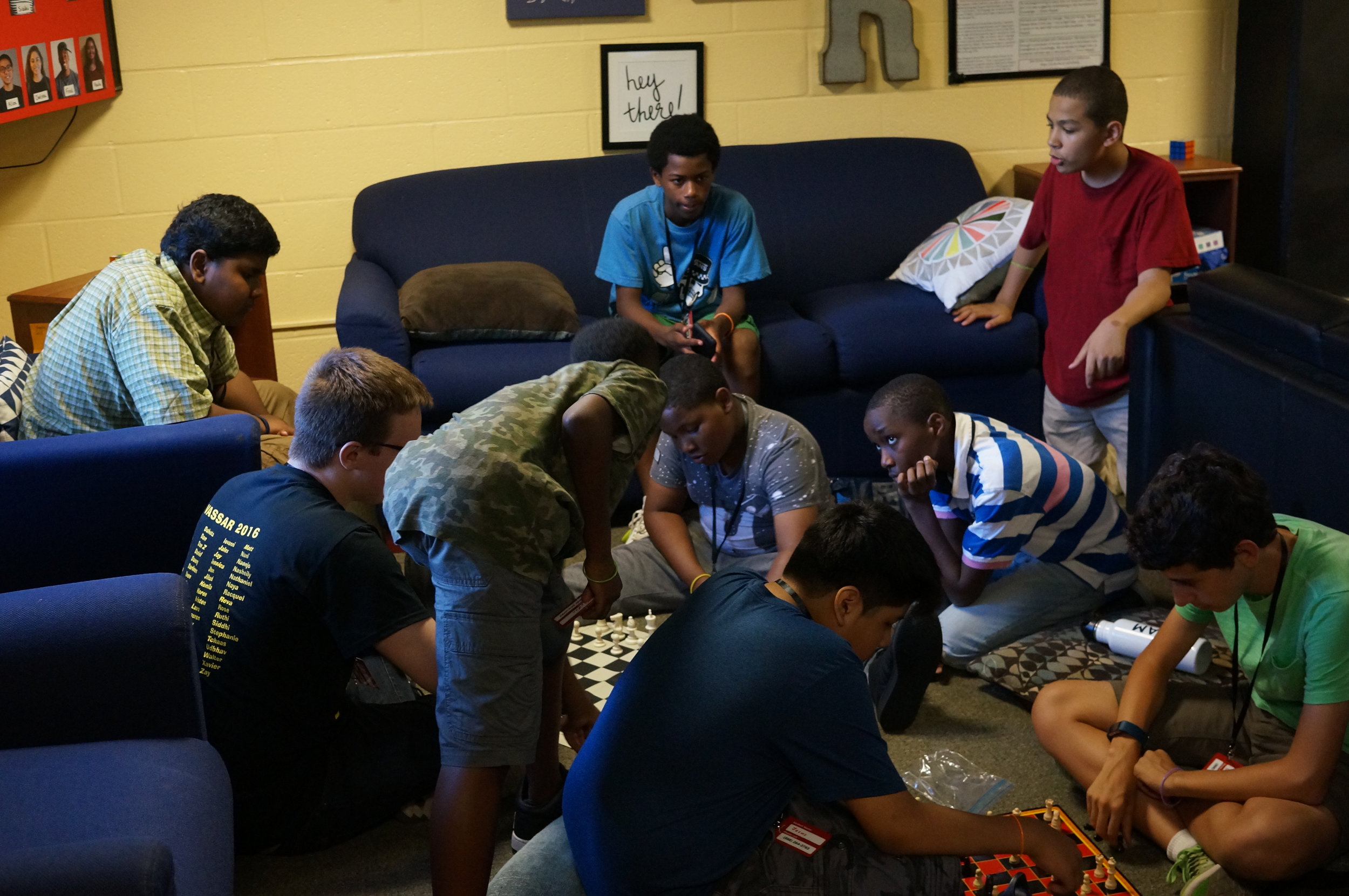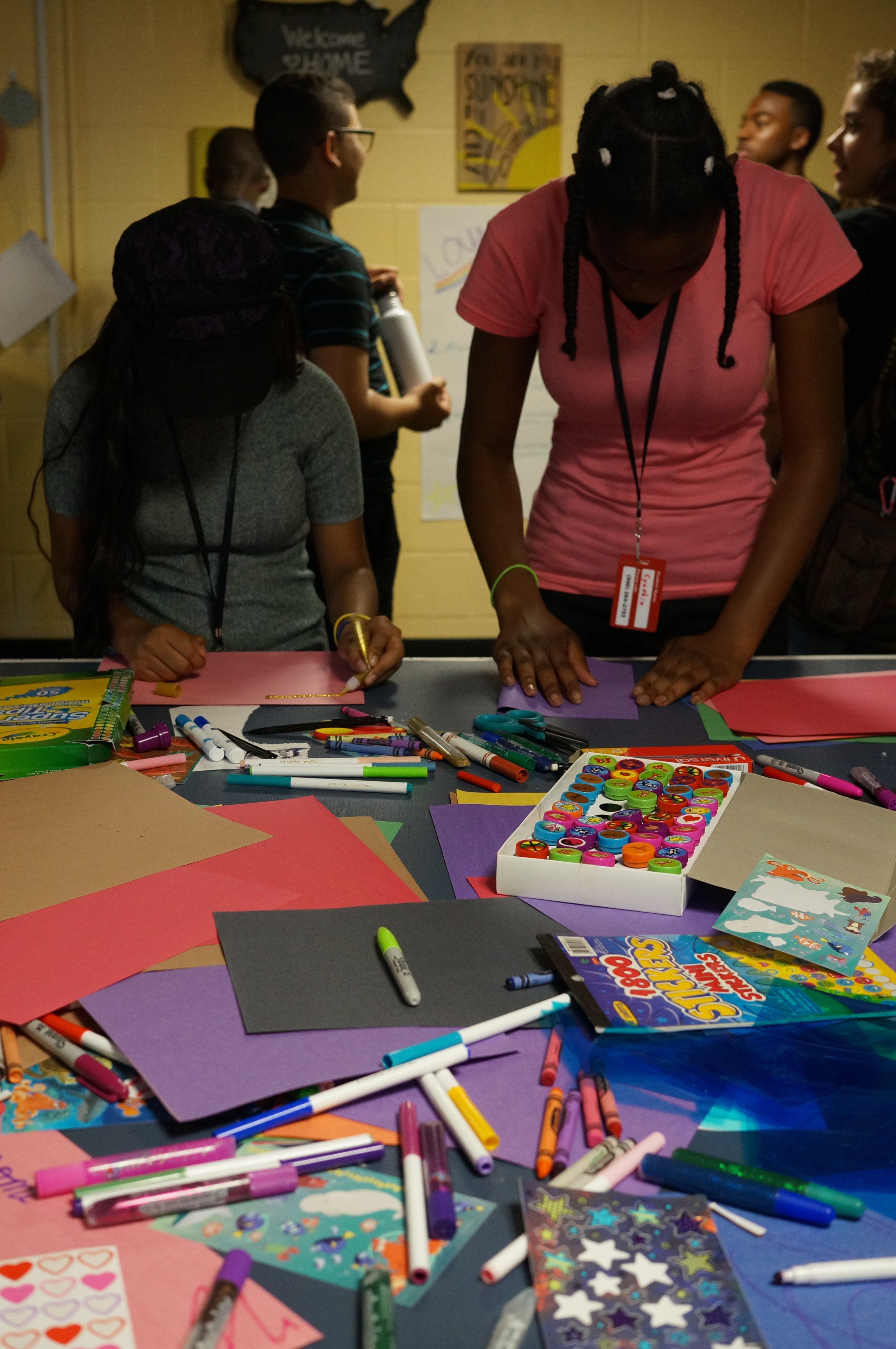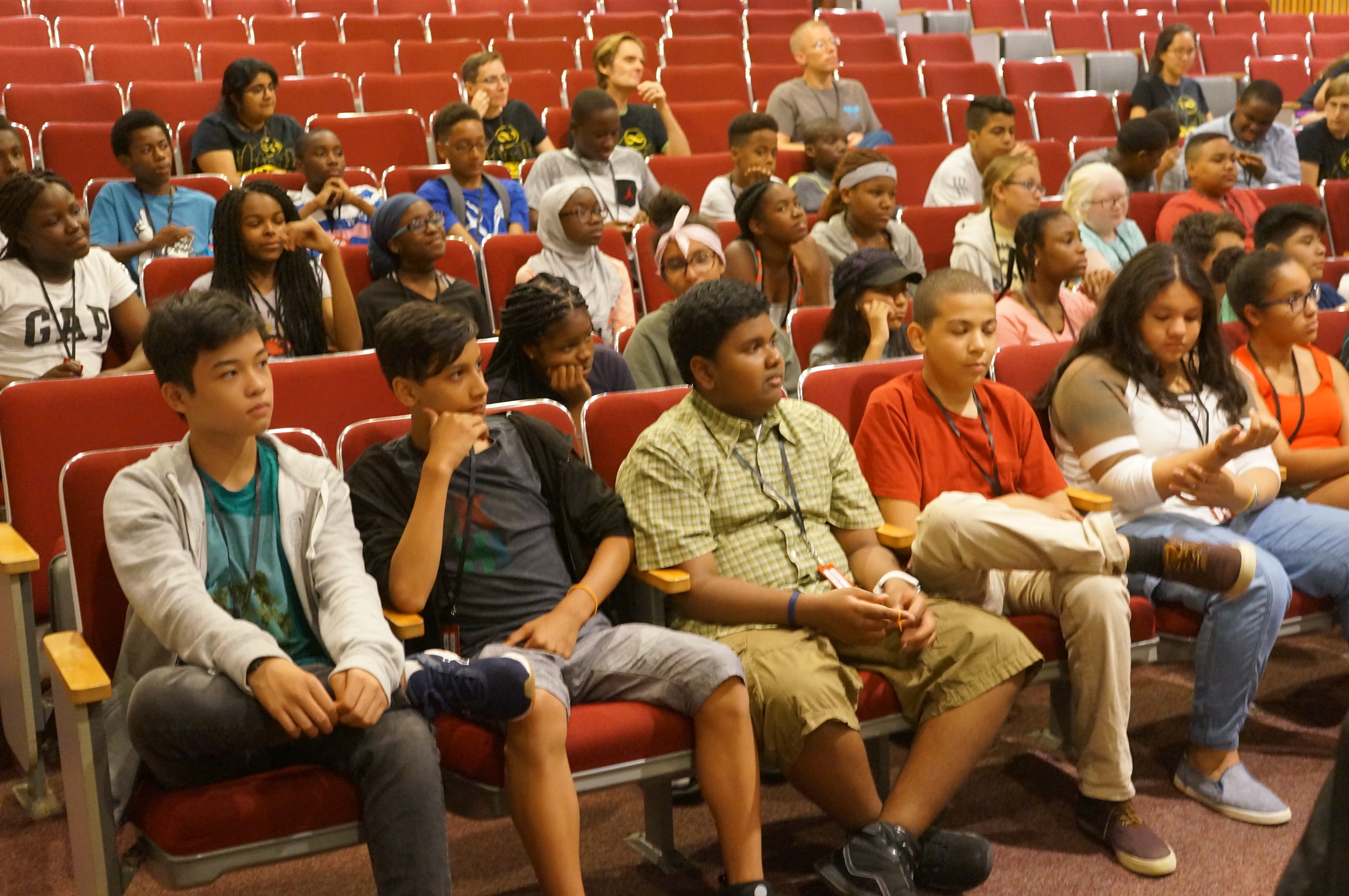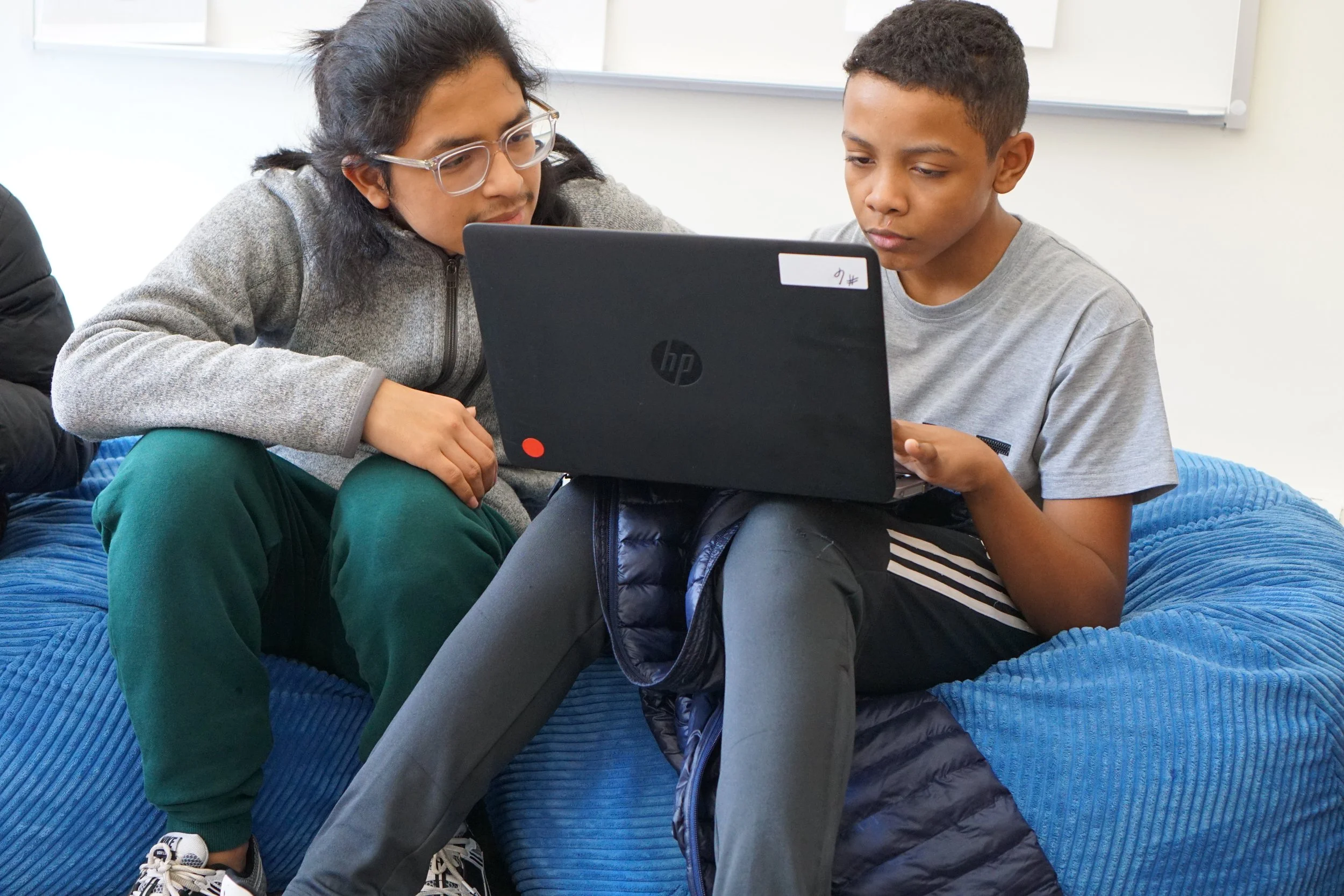
Welcome to the BEAM Blog!
BEAM Students Make Summer Plans
BEAM students and families gather for the summer program presentation.
After spending two summers at BEAM, what do BEAM students do next? They might want a summer break, staying home or traveling with their family for vacation. But many students want another productive thing to do with their time! Each winter, we encourage our alumni to apply for summer programs to help broaden their knowledge, explore enriching learning experiences, and spend their break in a meaningful way. This is especially part of BEAM’s mission to prepare under-served students for future STEM careers. We aim to support students by helping them to applying to various STEM orientated summer programs, and our unscientific surveys of STEM professionals prove what the BEAM audience already knows: summer preparation in middle school and high school opens the door to STEM success in college and beyond.
BEAM alumni Teo and Jennora share their experience from summer programs they have attended.
On January 26th, BEAM students gathered at NYU’s Courant Institute for the annual Summer Program Information Session. This event’s main focus was to start the process of selecting summer programs and preparing summer applications. The information session began with a presentation highlighting the importance of applying to summer programs and how to go about the application process. We also had a panel of four BEAM alumni who answered questions and discussed their experience in different types of summer programs. After hearing about the different options, students broke out into groups by grade in order to review a list of their personalized summer program recommendations. As the beginning of the year goes by, we encourage our students to start their applications as soon as possible in order to give themselves the best opportunities. Overall, the information session pushed students to start thinking about their pathways towards STEM careers in addition to giving students the chance to hang out with the BEAM family.
BEAM students: it’s not too late to apply to amazing opportunities for summer 2019! Contact your year leader to learn more.
BEAM 7 Students Look to the Future: Contemplating Careers in Math
When we ask BEAM 7 students what they see themselves doing as an adult at the beginning of the summer and then again at the end, their replies are always all over the map. Oftentimes answers change from one end of the summer to the other, and it can be hard to read from their response how their experiences at BEAM might have shaped the careers that they see for themselves in the future.
For example, mathematician is the only career that appears on both of Karen’s lists from before and after the summer; her responses seem to point towards a settled desire to pursue math. Meanwhile Amara only includes mathematician on his list at the end of the summer, hinting at a dramatic discovery of math. But their actual stories are more complicated, and at the same time richer: more reflective of what it really means and how it really feels to encounter advanced mathematics.
Amara doing a scavenger hunt, code-breaking activity.
Even though mathematician doesn’t appear among the careers that Amara can see himself pursuing before BEAM 7, his words on our opening survey already read like those of a budding mathematician.
I hope I become better and I want to achieve to become more of a person who likes challenge.
And when he writes about working on a math problem for days, it is clear that he is pressing towards that goal of embracing the struggle that comes with mathematics: It was so frustrating, but I never gave up.
John Urschel, former pro-football player and math PhD student at MIT, had something similar to say about his own earlier encounters with mathematics: It was so hard... And it was a struggle that I really loved.
Amara’s journey over the summer touches on a theme that is common to the study of advanced mathematics. Success in mathematics often means learning to love not just the mathematics, but also the toil that comes with it.
By the end of the summer, when we ask Amara what he likes about math, his response is a single word, one that captures the precise sentiments of many seasoned mathematicians: Challenging.
Karen folding origami.
On the other hand, Karen brought her desire to be a mathematician with her to BEAM and her goal to pursue mathematics did not waiver throughout the program. However, she did learn more about how it feels to pursue challenging mathematics, and the kind of community you want to have in your corner as you tackle difficult math problems.
This is what Karen had to say about what she learned at BEAM:
People aren’t really how you would think they are. There will always be someone with their arms wide open to pour feelings out to.
The larger mathematical community isn’t always a supportive one, especially for students of color. BEAM is out to change that, and we aren’t alone. Mathematicians of the highest caliber are beginning to recognize that humanity along with all her children, their history, their hurts and highest hopes, have a place in the midst of math. In the words of Francis Su, former president of the Mathematical Association of America and math professor at Harvey Mudd:
Math doesn’t happen in a vacuum, devoid of feeling or emotion. As Karen wrote about her experience working on a math problem for days: It was stressful, but after solving it I was satisfied.
Pursuing math is stressful! It is satisfying and rewarding and beautiful, but also (and often) stressful. The stress and the struggle are necessary aspects of pursuing math, worthy aspects of expanding the mathematical frontier. But the struggle doesn’t have to be a lonely one.
Every mathematician needs a shoulder to cry on from time to time, and that is what Karen found at BEAM, a community she can count on.
Only time will tell whether Karen and Amara choose to pursue being a mathematician as a future career, but they have already encountered currents that can carry them to the very heart of mathematics: the exhilarating joy of struggle and the strength of a supportive and understanding math community.
BEAM Alums Do Amazing Things: Summer Vacation Edition
BEAM starts with the summer programs we run (BEAM 6 and BEAM 7), but then encourages our students to apply to summer programs, internships, and jobs that keep their academic growth going. Here's what a few of our alums did during summer 2018!
Malachi, Mathworks Honors Summer Math Camp at Texas State University
Malachi holds the BEAM alumni record for most consecutive summers spent at a math program: six! After a summer at BEAM 7 (2013), Malachi attended MathPath (2014) and then the Mathworks Honors Summer Math Camp at Texas State University (2015-2017), which he returned to as a staff member this summer (2018).
Meet Malachi
Malachi is a first-year student at SUNY Binghmaton where he plans to major in actuarial science.
What did you do this summer?
I went back to Mathworks for a very different experience. Some of it was the same, like the camp environment. Some friends I remembered (but there are fewer of us in my grade each year). Above all, I had more responsibility. I had to grade papers, reading student proofs. We had to focus on where the information was both efficient and sufficient. We tried to follow a script, but each counselor has a different level for what constitutes a good enough proof. We were constantly trying to make sure we weren’t too lenient or too tough. With three years of writing proofs, you know what a proof is. So I told my students to focus on clarity and correctness. You can be clear about the wrong point. Or you can be correct but no one can understand your work. But if you meet those two requirements, the proof is right. That’s how I graded.
A big part of my job was being welcoming to the young kids. I worked to bring my social skills to the job because the students were so academic and I just wanted to make them feel comfortable, feel happy to be there. It was nice to be responsible for the well-being of other people. I chose to be a first year counselor because I knew I wanted to be welcoming to new students. I supported a mix of 9th-11th graders, but spent the most time with 9th graders. I even had one student who had finished 8th grade but had already finished Calculus!
In my spare time, I also took an optional course, where topology was the course being offered by a professor on campus for the benefit of the counselors. So I was studying and working.
Vielka, Malachi, and Crisleidy at their graduation from Brooklyn Tech. Vielka and Crisleidy spent summer 2018 working for BEAM as Junior Counselors at BEAM 6 NYC.
What was the application process like? Did BEAM prepare you in any way for that application?
Technically you have to apply. But I knew they had wanted me to return; they liked the skills I brought and the diversity (both ethnic and geographic). They didn’t ask me to complete the entire application process.
What was the highlight of your summer experience?
Being able to have the experience of building trust with new students, piquing their interest. I love having an impact on others. Some kids, I know I made their experience better. I did that. I’d already done the trips, the program itself, so the main focus for me was being the favorite counselor for some students.
What was something unexpected about your summer experience?
It was exactly what I expected. There were times when the workload was overwhelming, especially when my topology class had to be balanced against the grading. So I learned to balance my work (which I have always done) but also the work of everyone else in my group. But I knew that responsibility was coming.
Why did you keep going back to Mathworks?
This year, the money was a big factor! But at this point, it’s comfortable. It’s an environment I want to be in. Folks have similar interests. I know I will meet people who I like to be around, I like to converse with. I want to have that impact that other counselors had on me in the past. Each year, there are people I want to see again, math I can learn that I’m interested in, research that I want to get to do. It’s a family bond, a family atmosphere, a bond I have. I love that BEAM is 3 weeks, but Texas is 6 weeks. Just imagine how much stronger the bond is!
Malachi attends MathPath, 2014.
Zeñia and Teo, Cooper Union Summer STEM
Both Zeñia and Teo were accepted into this very competitive program! We asked them each about their experiences.
Meet Zeñia!
Zeñia is a 12th grader at St. Mark's School, a boarding school in Massachusetts.
What did you do this summer?
I took a racecar engineering design class. The class split up and each group focused on a different component of a racecar. My group worked on the “impact attenuator”, which is something that purposely deforms to protect the driver in case of impact. We wanted to find the best shape and material for an “ideal crash.” We wanted to work with carbon fiber rather than aluminum which is used currently. Our job was to figure out what the ideal attenuator would be for a racecar crash. We used a testing rig (put weights and crush it) to test out prototypes. We built a lot of prototypes. We chose which was best and modified it accordingly.
The program lasted for 6 weeks. We did presentations every week. Presenting was a great skill I can take back for my own future.
What was the application process like? Did BEAM prepare you in any way for that application?
They had you write an essay about why you were interested in STEM and spending the summer doing something in this field. Sarah at BEAM helped edit my essay.
Oscilloscope graph.
What was the highlight of your summer experience?
Understanding the oscilloscope because no one on our team knew what it was. We were able to understand it, graph data and analyze the date. After this we made the prototype and then “crushed it.” [See below for what that looked like!]
What was something unexpected about your summer experience?
I’ve been used to going to summer programs that are sleepaway. The idea of commuting to a college campus and it took me some time to adjust. I had to go home at the end of the day. I expected to get tired and annoyed, but I didn’t, which was a great realization.
Would you recommend this summer experience to other students? Why or why not?
Yes! Definitely, I would. I knew I was interested in mechanical engineering and knew this experience would be great for me. Even if you don’t know what specifically in engineering you want to do, there were a lot of programs to choose from. The team and faculty were very supportive and helpful. You didn’t need prior knowledge; everyone was willing to teach you. This was helpful in helping me figure out what type of engineering I wanted to do.
Crushing the prototype!
Meet Teo!
Teo is a 12th grader at Millennium High School.
What did you do this summer?
I played Fortnite—just kidding. I did a STEM program at Cooper Union for 6 weeks. I chose the "STEM to STEAM Rube Goldberg Project" because I saw a video about this that BEAM sent out to us when they were telling us about the opportunity at Cooper Union. We were put it to teams where we were tasked with creating a kinetic sculpture which is basically like a “moving art piece” where we had to answer the question “What Does NYC Mean to You?” We created a marble machine that went through all parts of NYC. There were electronic parts. We built parts and 3-D printed components. It was a combination of constructing and engineering.
What was the application process like? Did BEAM prepare you in any way for that application?
They required transcript and an essay asking why I wanted to be a part of the program. BEAM helped because I wrote the essay the day before it was due and Dan really stuck by me through the night and helped me revise my essay. Disclaimer: don’t do this.
Teo shows his kinetic sculpture to other BEAM 11th and 12th graders during a college tour of Cooper Union.
What was the highlight of your summer experience?
Getting engineering experience. I learned to use laser cutting machine, how to 3-D print, and how to do circuitry work. I also used hand saws and electric saws to cut through tough material. I used a lot of tools.
Would you recommend this summer experience to other students? Why or why not?
If you’re in to engineering, yes! It is a good experience. Or if you want to find out more about engineering it might be a good way to determine if it’s for you before you go to college. Now I really want to study engineering because it was fun.
Adrianne, Black Girls Code
Meet Adrianne!
Adrianne is an 11th grader at NEST+m.
What did you do this summer?
I spent the summer with Black Girls Code. Over the course of the program, we first learned how to build websites, and then apps.
What was the application process like? Did BEAM prepare you in any way for that application?
BEAM introduced me and my mom to the program and then my mom signed me up. There wasn’t much of an application!
What was the highlight of your summer experience?
Presenting the final project: my app. What I made was a dog app, and it basically helps you find your lost dog. I had to make a map which is very hard. Very hard!
What was something unexpected about your summer experience?
The sense of community that I built. I didn’t expect to be as close within a 2-week period as I was. It was really intense. We also got to go on some trips too.
Would you recommend this summer experience to other students? Why or why not?
Yes, definitely. Not only does it allow you to know more about computer science in general, but also we went on trips to different companies and you hear about the different companies. Above all, it was a program with like-minded people who want to achieve the same goal as you.
Maria, Lenox Hill Hospital Radiology Internship
Meet Maria!
Maria is a 12th grader at St. Jean Baptiste High School in the Bronx.
What did you do this summer?
I did an internship with Lenox Hill Hospital (where Beyonce gave birth to her first child). I was assigned to the pathology dept (where they do lab work, including bloodwork, surgical specimens, and more). My mentor made sure that I got to rotate through all the different part of Pathology: surgical path, chem path, hematology path for examples. I was introduced to all lab leaders in each department. Also, on Wednesdays, we had enrichment days where everyone in the program got together with the director of the program and we would meet different people in the hospital or do surgical tours. We got to see the inside of an OR (operating room) and I saw two operations from next to the operating table. I saw a mastectomy and breast reconstructions and also an above-the-knee amputation. Through glass, I saw an “angiogram”—to check blood flow in the brain.
In surgical pathology I got to see different specimens that came in. For instance I saw breast tissue that was taken from a mastectomy. I also saw a fetal autopsy on a 15 weeks fetus.
Infectious diseases under the microscope.
In hematology I looked at slides under a microscope. I saw malaria-infected cells and cancer-infected cells. I also saw how they prepped the slides.
I got to meet the doctor who the movie Brain on Fire is about. I was starstruck. Dr. Najjar is a very famous doctor who made a groundbreaking discovery in medicine.
What was the application process like? Did BEAM prepare you in any way for that application?
There is a partnership through my high school; my guidance counselor approached me and told me to apply. I had to complete an application, write an essay, and go through an interview. I also had to provide info about my grades. I was the first interviewee and I was very scared. They asked me about stuff I wrote in my essay, such as how the program would benefit me and my interests in medicine. In the interview, I talked about BEAM as a program that has guided me.
Yes, BEAM helped me throughout! I had Sylvia read my essay a bunch of times.
What was the highlight of your summer experience?
Networking. What 17-year-old can say they have connections with doctors at a hospital? It’s also something substantial to put in my college application.
Watching the mastectomy was another highlight. It was a 9-hour surgery, I was there only for four and it was exhausting for me. The surgeon was also teaching his students. On top of leading the surgery, he was also teaching, which is important and definitely something that I want in my future when I go to med school.
Would you recommend this summer experience to other students? Why or why not?
I would say yes, but only if you’re considering a profession in health and medicine because it definitely makes or breaks it. You either love it or hate it. You see the hospital as it is—it’s not like watching Grey’s Anatomy.
Isabella, NYU Tandon School of Engineering's ARISE
Isabella presents her passive dynamic walker at the end of the summer.
Meet Isabella!
Isabella is an 11th grade at Manhattan Center for Science and Mathematics.
What did you do this summer?
I was in a research placement at a mechanical engineering lab at NYU’s polytechnic campus in downtown Brooklyn.
What was the application process like? Did BEAM prepare you in any way for that application?
It was all kind of a blur because I was doing it way back in January. I didn’t expect to get in, because I really struggle with writing. The essay process was rough and it took a lot of my time. Each week, at BEAM Next Saturday classes, we took some time to break down what was required to apply and how to meet necessary deadlines. That really helped me get the application done and get in.
What was the highlight of your summer experience?
Being able to understand complex computer languages that I haven’t before. We learned to use Arduino and Matlab.
What was something unexpected about your summer experience?
It was kind of hard. But other than that I felt prepared for everything.
Would you recommend this summer experience to other students? Why or why not?
Yes, I would recommend it. But I don’t know if their experience would be the same as mine, because there’s different labs in different buildings. You get what feels like a real college experience.
Jennora, Met PALS Internship
Meet Jennora!
Jennora is an 11th grader at Bard High School Early College.
What did you do this summer?
The Met PALS program (Metropolitan Hospital Center Preparation for Achievement in the Life Sciences) is prep for people who want to go into medical field. You get a chance to figure out what exactly you want to do in the medical field. You’re walking in the hospital, with your coat on, watching what’s going on and talking to the staff. There’s also lectures about how you become different types of medical professional.
What was the application process like? Did BEAM prepare you in any way for that application?
It was not that rigorous! I was volunteering at the hospital already and the coordinator told me that Met PALS would be a chance to do more intellectual tasks. So then I filled out some forms and there was an interview, but I didn’t have to write an essay.
BEAM has helped me over the years get into programs: how to write essays, answer questions, do paperwork. Now I can apply for things by myself and I can be independent and I know what to do, but if I do need BEAM for an application or a recommendation letter, I know you’re always there. That support is so helpful.
In the past, BEAM has helped Jennora with her successful applications to GOALS for Girls and Center for Excellence in Youth Education (CEYE) High School Summer Program, where she studied zebrafish toxicology.
What was the highlight of your summer experience?
So much! Surgery was amazing; I would have never have expected being able to watch a real surgery in the Operating Room. But there was so much more to the program. I loved the overall experience, being by yourself, walking around the hospital, being independent, being surrounded by adults who know what they’re doing. It felt mature and independence. I grew so much as a person.
What was something unexpected about your summer experience?
Surgery! Didn’t know I would see that. I got to change into scrubs and be on the inside. In some departments, you would talk to patients and even hear private information. It was crazy to see a biopsy in front of my eyes!
Would you recommend this summer experience to other students? Why or why not?
Of course!! There were only 10 of us in the cohort. Lots of freedom. Plus, I’m curious about the medical filed and I really got an inside look. There are so few opportunities at my age to understand so many things about the medical field. I’d never heard of residency before doing this! I saw radiology, PT, OT, internal medicine, NICU. I explored the whole hospital.
Porter, Center for Talented Youth
Meet Porter!
Porter is a 9th grader at the High School of Telecommunication Arts and Technology in Brooklyn.
What did you do this summer?
I played a lot of video games... I also went to the Center for Talented Youth (CTY) and took an engineering class, which was basically an intro to the engineering process.
What was the application process like? Did BEAM prepare you in any way for that application?
The application process was not really so stressful. You had to take a test, and then find out if you qualified. Then, you got to select what classes you wanted and which location. BEAM facilitated the test and helped me study for it.
What was the highlight of your summer experience?
Meeting other people interested in the same things as me.
Would you recommend this summer experience to other students? Why or why not?
Yes. It was really fun. It was also really interesting and instructive.
BEAM's Pre-Summer Newsletter is Here!
Last Friday, BEAM's quarterly newsletter arrived in the inboxes of all our subscribers! The newsletter featured:
- An update on BEAM's growth (380 students at BEAM programs this summer!)
- Congratulations to our 12th graders on their college plans
- "What We're Reading"
- Updates on BEAM Los Angeles
Missed the newsletter? You can always read it online. And make sure you don't miss the next one! Sign up for our mailing list.
Advice for Your First Summer at BEAM
Recently, we sat down with some of our older BEAM students to ask them what advice they would give to new students entering BEAM for the first time. Here's what they had to say!
Zavier at All Star Code, 2015.
Zavier just finished his sophomore year at SUNY Albany where he has declared a major in computer science and a minor in art. He was a member of BEAM's first ever summer cohort: 2011. He was a Junior Counselor at BEAM 6's first summer (2016) and became of the first two BEAM alumni to work for us as full Counselors in 2017 (counselors must have completed a year of college). In 2018, he's flying to Los Angeles to staff the first summer of BEAM 6 LA. Beyond BEAM, Zavier was a member of the first ever cohort at All Star Code and he has extensive experience in coding, maker spaces, and teaching tech skills. Lots of firsts for Zavier!
What should students expect from BEAM?
Students should expect to be encouraged to learn and be challenged by the questions they're given. They should expect to have people around them willing to help them through problems whether those problems have to do with math or not. Most importantly, students should expect to have a good time. BEAM is where I met some of the good friends I have today and I still look back on that summer remembering some of the fun times that I had.
Zavier plays tennis at BEAM 7 in 2011.
What advice would you give to a student starting BEAM?
The advice that I would give to a student starting BEAM is: don't feel discouraged by hard problems and don't be afraid to ask for help. BEAM helped me realize that as we grow, things become more difficult and problems seem to require more thought. Practicing patience and deeper thinking is all part of the process.
Why do you keep coming back to BEAM?
I keep coming back to BEAM because of the supportive staff. BEAM has opened the door to a lot of opportunities for me. They helped me when I was applying to high schools, they helped me when I was looking for summer programs, they helped me apply to college, and they even helped me find a job. It feels good to know that I have people who are always willing to help me out and it motivates me to do my best!
Zavier teaches Javascript to Elvis at BEAM 6 in 2017.
Tanasia at College Decision Day, 2018
Tanasia, 12th grade, will be attending the University of Rochester in the fall where she plans to major in math. She has spent three summers at BEAM, as a 7th grade student in 2013, and then as a Junior Counselor at BEAM 6 in 2016 and 2017. During the school year, she coaches two math teams at BEAM partner middle schools, including one at her own alma mater!
What should students expect from BEAM?
The math will be difficult; you won't get it right away. You might even struggle for the first two weeks! But you'll expand how you look at math. You'll make friendships and connections that will last for a long time. It's a new, fun experience.
What advice would you give to a student starting BEAM?
Don't be afraid to ask the staff for help! Also: even with math, the counselors don't know everything. That's normal in math, not to know everything.
Why do you keep coming back to BEAM?
I love to see where the students start and where they end. They evolve as mathematicians and they can solve problems they couldn't do before. It's amazing.
Tanasia plays chess with Jack, BEAM 6 (2016)
John showing his school pride!
John just finished his freshman year at Fordham University, where he plans to declare a major in chemistry. He is also taking pre-med coursework and aims to be a surgeon. John attended Bard High School Early College and graduated with both a high school diploma and an Associate's Degree. He attended BEAM 7 in 2012, and has contributed to BEAM in so many ways since! He was a junior counselor at BEAM 6 in 2016 and 2017, he is the TA for our 8th grade Algebra class, and he works in the BEAM office as an part-time assistant during the school year. In summer 2018, he and two friends who also attended BEAM 7 in 2012 (Joel and Quentin), will be counselors at BEAM 7 Bard College. They are the first BEAM alumni to go back as staff to the exact same program they attended as students!
What should students expect from BEAM?
I was expecting math all day and not much fun. But you should expect to be in a community of math lovers. For me, the community was the thing. I enjoyed being in a space where everyone loved math, shared my interests. Expect to be in a loving, math community. Expect to be challenged. Expect to make amazing friends you'll keep for a century. Expect to have fun: trips are amazing, the food is good, activities. It's not just math all the time; it's something immersive.
What advice would you give to a student starting BEAM?
Keep an open mind. It may seem tedious to lose your summer, but you'll have fun. I was afraid the first day. So, be open. Step a little outside your comfort zone. Those might be your friends for the rest of your life.
Quentin (left, red cap), John (next to him), and members of the BEAM 7 community in 2012 during a karaoke activity.
When you spent that first summer with us, did you ever think you would end up being such good friends with Quentin?
He came up to me. I don't remember what he said. But ever since then, we became friends, playing basketball. BEAM helped us stay friends because they introduced us to the same high school. So I've stayed friends with him ever since. Derek, too! I didn't get to know Derek much that summer, but we became friends during high school and we still talk.
Why do you keep coming back to BEAM?
Honestly? I want to stay part of a community that's so supportive, loves math. I want to give back. BEAM helped me move in the direction I'm moving in now. I want to influence the next generation as they figure out their path. It's an amazing program, amazing community that should continue to exist and I want to help that.
The BEAM 6 group photo from 2017! Quentin (white jacket) is in the front row and John is all the way in the back. Mona, Zavier, Tanasia, and Rashik are here, too: Mona is in the front, on the left, Zavier is wearing a black cap in the middle on the right, Tanasia is in the middle, near the back, and Rashik is in the center, left with a baseball cap on.
Crisleidy at the Moth City Slam, spring 2018.
Crisleidy is graduating from Brooklyn Tech this June. She's taking a gap year next year, working at City Year (an Americorps program). During the year, she volunteers at BEAM Next, our program for 9th and 10th graders, teaching life skills (like study skills). This summer, she will be a Junior Counselor at BEAM 6 in NYC.
What should students expect from BEAM?
To step out of your comfort zone. There's a lot of new stuff. I didn't know any math, puzzle, logic games before the summer and then I got really into them.
What advice would you give to a student starting BEAM?
Learn how to play chess! There's people at the program who know and they'll teach you. Try everything once! There might be something you enjoy. But you don't have to try anything you're not comfortable with.
Why do you keep coming back to BEAM?
It's fun. I love the people. A nice community, a family. I can't get enough! Plus, I appreciate all the help I've gotten.
Crisleidy plays her favorite board game, Ricochet Robots, at BEAM 7 in 2013.
Rashik, volunteer math grading in 2018.
Rashik is an 11th grader at Bard High School Early College, which means he's currently dual-enrolled in "Year 1", the first year of his Associate's Degree. Rashik attended BEAM 7 in 2014. He was a Junior Counselor in 2017 and will be returning to that role in summer 2018. During the school year, he coaches math teams at two BEAM partner middle schools.
What should students expect from BEAM?
I think students should expect it to be an uncomfortable environment at first but once they're in the flow of things they'll love what they're learning and that they're surrounded by people that who also love what they're learning. Also, students should expect work they've never seen before: they may be confused by it, or it might take them longer than their normal math questions.
Rashik presents the solution to a challenge problem at BEAM 7 in 2014.
What advice would you give to a student starting BEAM?
The most important advice I'd give is that you have to persevere and keep working even when it gets really frustrating. There's no feeling worse than being stuck on a problem forever, but there's also no feeling better than finally solving that problem. In terms of social advice, I'd tell the kids to be themselves. There are other amazing kids at BEAM, so be brave and try to make new friends and have new experiences.
Why do you keep coming back to BEAM?
I keep coming back to BEAM partly because I made some amazing friends and that small circle still exists today. But also because the open environment that BEAM has established makes me always feel welcomed; I feel like I can go to them for any problem. I always feel like I have a community outside of school or home that I can go to for help. Plus, BEAM also takes me to Yale every year which is pretty cool.
Rashik, Eli, Tanasia, and Andy in January 2018 at our MATHCOUNTS prep event. All four of these high school students coach math teams at our partner middle schools!
Mona at BEAM College Day, fall 2016.
Mona is graduating from the Academy for Software Engineering this June. She'll be attending Barnard College as a HEOP Scholar this fall. She plans to major in mathematics with a computer science concentration. During the year, Mona is the TA for BEAM's Saturday programming class (for 9th and 10th graders). She was also been a Junior Counselor at BEAM 6 in 2017.
What should students expect from BEAM?
To have a lot of fun. Honestly. You might not expect that. Maybe your parents pushed you to do it. But it's not like school, it's fun. At the same time, expect it to be challenging.
What advice would you give to a student starting BEAM?
Be open minded. Lots of activities you might not be sure about. Don't say: I'm not good at this, I don't want to try it. Check it out!
Why do you keep coming back to BEAM?
It's a family! It's relationships. The people are easy to talk to, they make you feel comfortable. That sounds cheesy but it's true.
Mona (front) with a dozen BEAM students at our annual Slightly Mathy Trivia Night, fall 2017. Crisleidy, John, and Rashik are also pictured!
Center for Talented Youth Admissions Results
On Saturday, December 16, 25 BEAM students took the admissions test for the Center for Talented Youth (CTY). CTY offers students three-week summer programs in math, science, English, and humanities, provided they score well either the math or verbal section of an admissions exam (the SCAT).
This week, we found out that a 18 students passed the test, qualifying to take either math or verbal courses, or both! Next summer, they could take courses ranging from Discrete Math to Astronomy to Philosophy. CTY's summer programs normally cost about $4000, but their exemplary financial aid means that the median BEAM student pays only $100 to attend.
Congratulations to Jordan, Mariwa, Consuelo, Awa, Yeramis, Mohamed, Anthony, Noe, Emyr and 9 other students who have opened a door to the next opportunity! We are so proud of you all.
Weekend 2 at Bard: Debates, Relays, and Field Day
Instructor Tanya gathers the attention of members of the Orange Team as everybody prepares for Field Day activities.
It has been a jam-packed weekend at Bard BEAM 7, with Saturday marking the end of week 2 courses, an impromptu student-vs.-staff debate, round 2 of relays, and an all-day Field Day concluding with a student-vs.-staff game of capture the flag.
Saturday Highlights:
Saturday was marked by a sudden decision which will likely leave a lasting legacy at BEAM 7: a program wide debate. After some quick logistical considerations, the plan became to have four rounds of student vs. staff debates, with the groups of student and staff debaters changing with each round. The groups of students who debated against staff were determined earlier in the day by having various groups of students practice debating against each other, with the staff choosing the groups which they believed would pose the biggest challenge.
So about what exactly did we debate? After careful consideration, the debate moderators--consisting of counselor Dave as well as students Jade, Camila, and Anthony--decided on four pressing, relevant, and emotional topics. At the beginning of each round, each side was randomly assigned to either argue FOR the issue at hand, or AGAINST it. The topics were as follows:
- Should high school students be guaranteed a daily recess?
- Should BEAM allow cell phones at all meals with out any rules?
- Should Modules be abolished from the BEAM program?
- Does pineapple belong on pizza?
After each round, all individuals who did not participate in that round got to vote on which side they thought argued their stance better. Staff won rounds 1 and 4 arguing for required recess and pineapple on pizza. Students won rounds 2 and 3 arguing against allowing cell phones but arguing to keep Modules in BEAM.
Immediately following these intense debates were another round of relays. Relays are a team-style competition where students complete problems in order to gain points. The teams with the most points get to choose from a selection of neat prizes! Check out some pictures of the event below.
Sunday: FIELD DAY!
First of all, what constitutes a "Field Day"? Field Days can take many forms, and the exact schedule of one can vary across different summer programs. The general idea, however, is a day full of fun activities in which teams compete against each other to earn points--the team with the most points at the end of the day wins! For BEAM's field day, the winning team was rewarded with an extra helping of dessert at dinner.
Field Day!
After starting the morning with a late breakfast, students and staff divided up into the four field day teams: Red, Green, Purple, and Orange. With two staff members leading each team of 10, Field Day began with a 30 minute team meeting where strategy for the first event was discussed and face paint was distributed to get into the spirit of each team's color. Once everybody was decorated and ready, field day began! Here was the schedule of events:
- 11-12 Photo Scavenger Hunt
- 12-1 Break for Lunch and Opening Ceremonies
- 1-1:30 Team Relay - Ping Pong Ball Balancing, Hula Hooping, and Jump Roping
- 1:30-2 Human Knots
- 2-2:45 Dance Off Competition
- 2:45-3:15 Frisbee Throwing for Accuracy and Sponge Relay
- 3:15-4:15 Tug of War and Break
- 4:15-5 Water Balloon Fight and Water Balloon Cleanup Competition
After all the activities were finished, students got some down time before heading to dinner, with a game of Capture the Flag--again, students vs. staff--following dinner. Check out field day photos below!
“I really enjoyed field day because I got to do things that I’ve never been able to do in the city before. Playing tug-of-war, having a dance off, and participating in a water balloon fight were all incredible.”
Welcome to Bard!
We started the day with families and staff meeting at Bryant Park. Everyone was super excited to meet the students, and they all made a great first impression! Everyone took the documentary crew in stride and we began to see many friendships forming. Especially when students and staff went out for lunches.
The students then boarded the bus and were off to Bard! Upon arrival, they were given tours, got to know the campus, and soon got right to problem solving and game playing.
An entry from a student:
“At first I was very nervous to arrive to BEAM, but as soon as I got to see a few familiar faces and began to have great conversations with my peers, I was really excited to start classes.”
We can't wait to see how these students grow over the next few weeks, and to share some of this amazing experience with all of you!
Day 0: Welcome to Union College!
Sunday, July 9, 10am: our staff arrive at Bryant Park and wait for the students to arrive!
The first students join us for board games (like Blokus!) in the park. After a filling lunch, the bus departs and we're on our way to Union!
At 4pm on Sunday, our bus arrives to Union! It's time to unload our luggage, get keys, unpack, and explore the dorm, including making door decorations!
Then, we ended the day with a welcome meeting so we know what to expect for the rest of BEAM. Welcome to Union!















